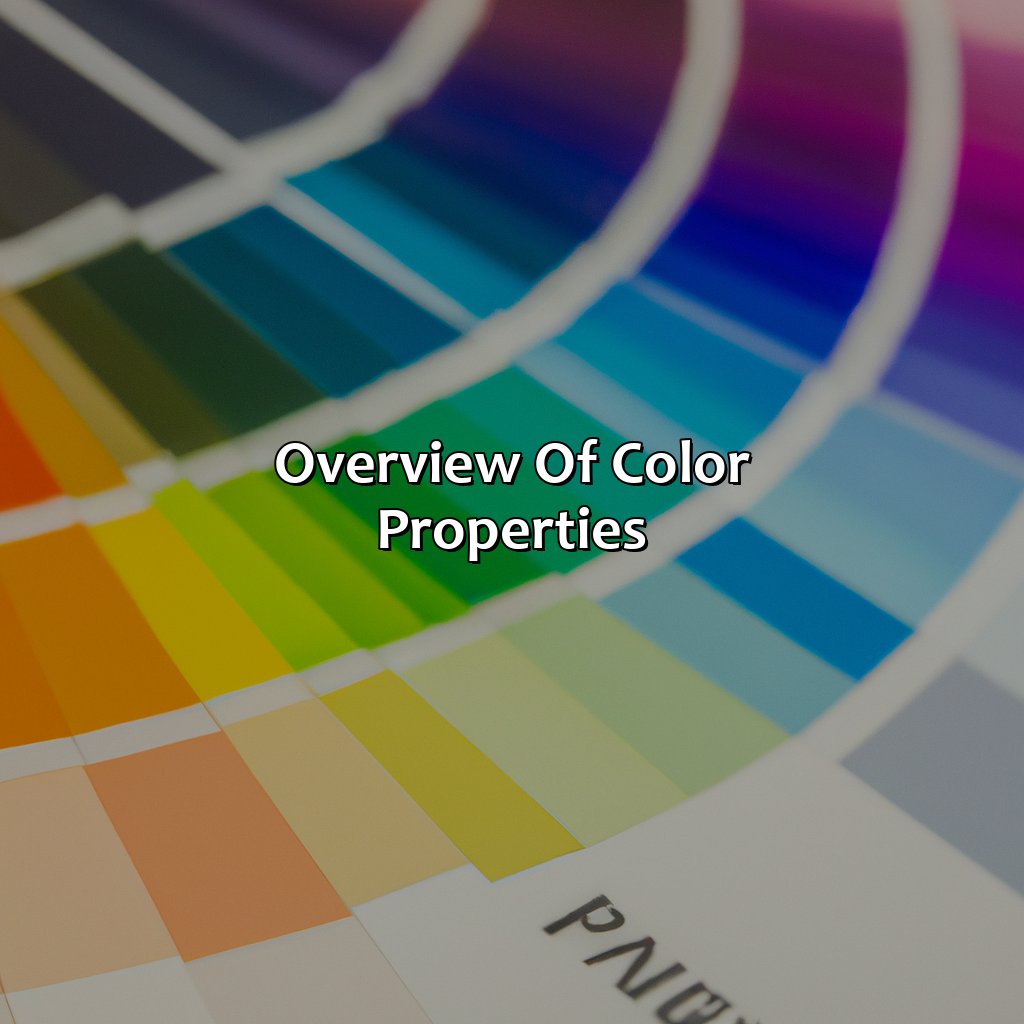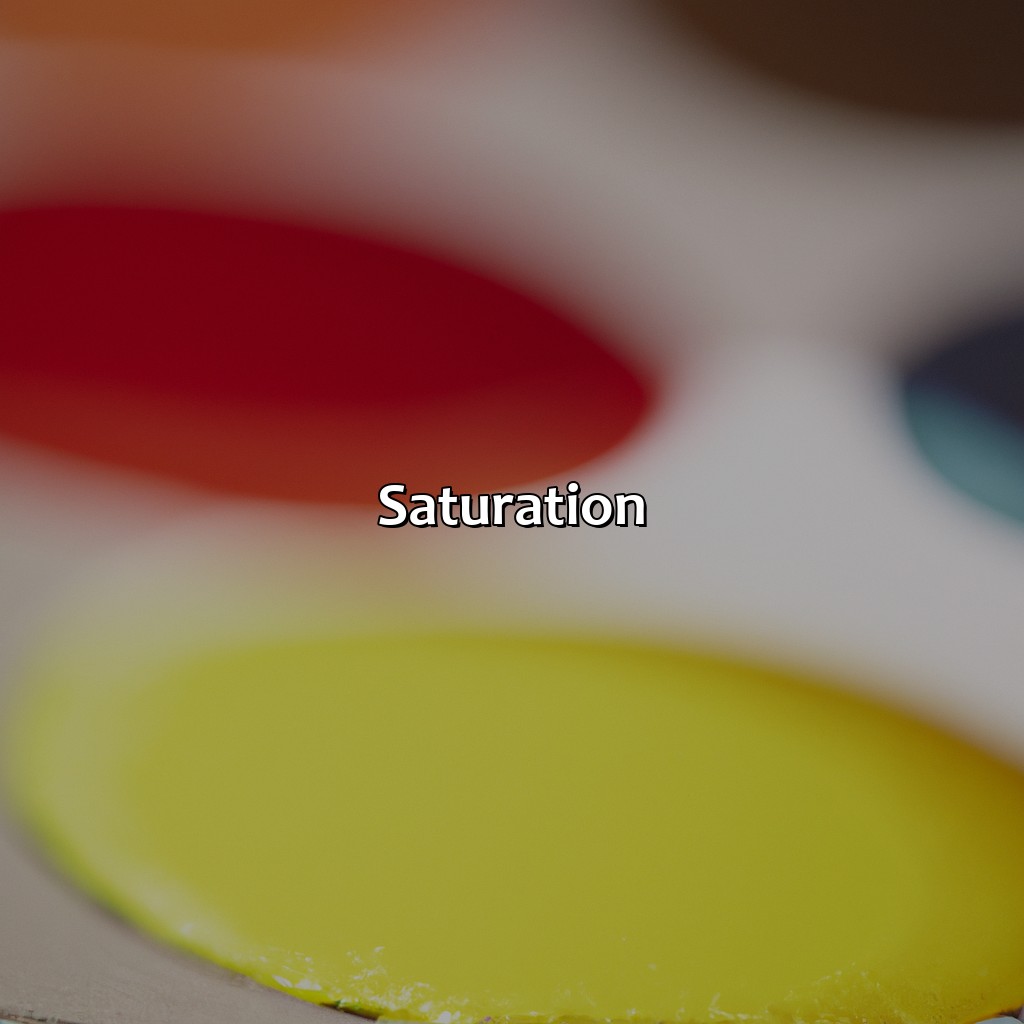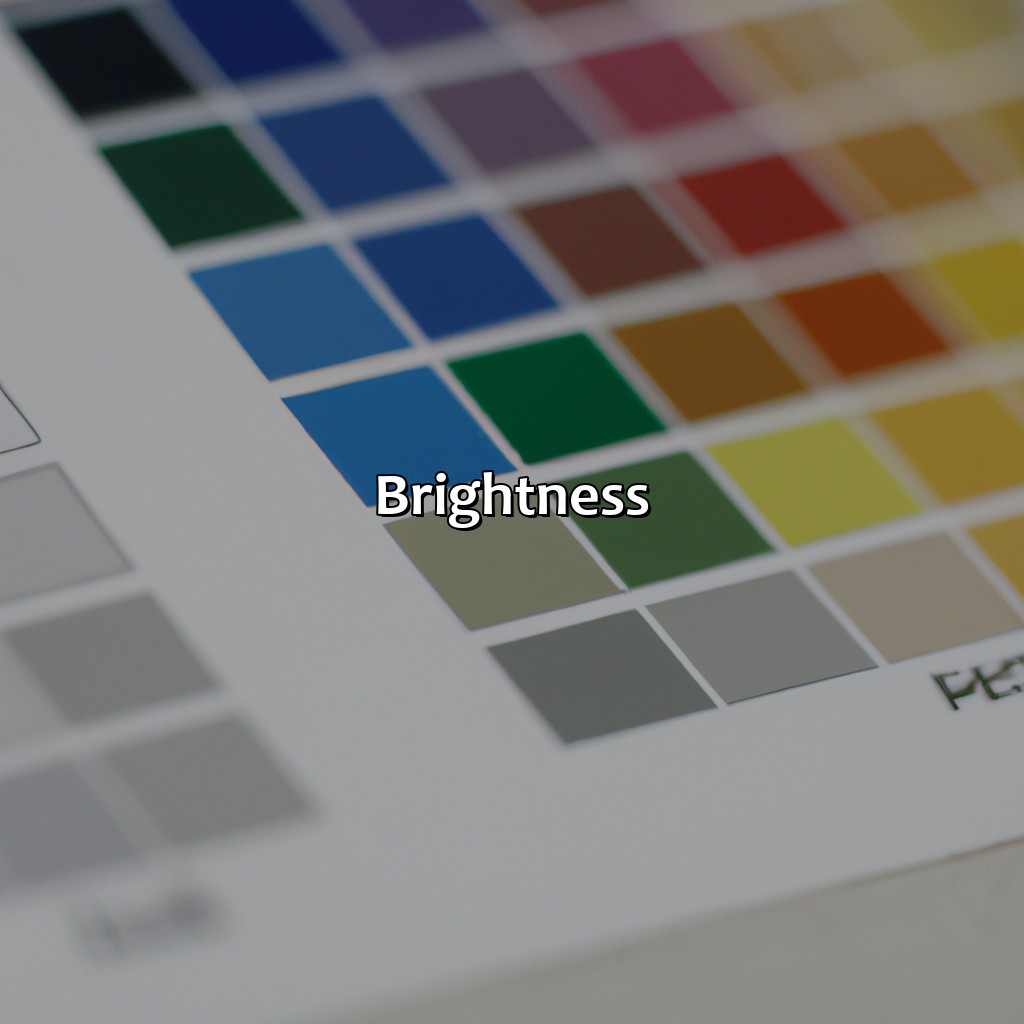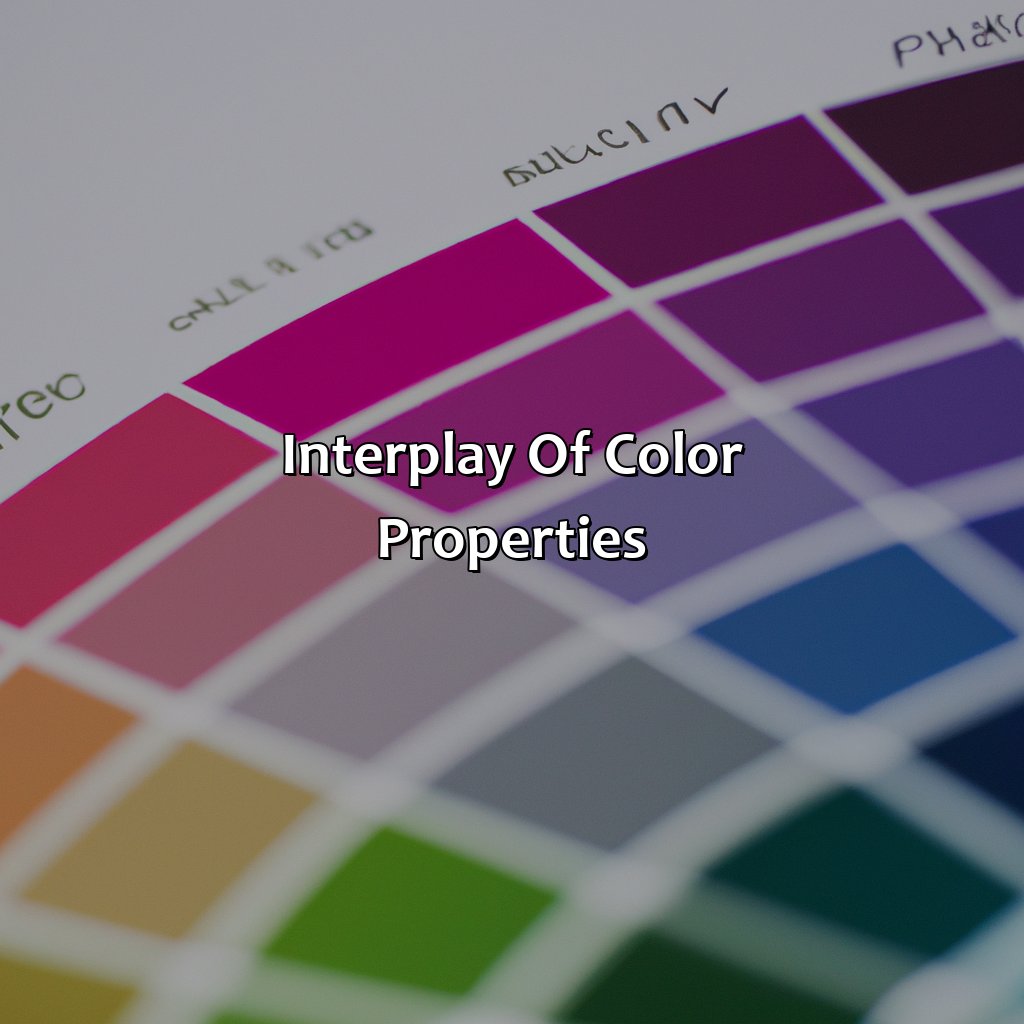Key Takeaway:
- Hue is one of the primary properties of color, defined by the primary, secondary, and tertiary colors, and can be manipulated through color mixing, color wheels, and complementary and analogous color schemes.
- Saturation is the intensity of a color and is affected by factors such as chromaticity and color theory. It plays a role in visual perception and can be used to create both bold and muted color palettes.
- Brightness is a property of color related to the amount of light reflected or emitted by a color and can be affected by color temperature and light sources. It also plays a crucial role in visual perception and can be used to create contrast and balance in design and art.
Overview of Color Properties

Photo Credits: colorscombo.com by Larry Gonzalez
Color is a complex visual sensation determined by three main properties – hue, saturation, and brightness. Hue is the specific shade of a color, while saturation refers to its intensity or purity. Brightness is the amount of light reflected by a color. These three properties are crucial in color perception, as they determine how we perceive and distinguish different colors. By understanding the properties of color, we can create visually appealing designs and communicate effectively through color choices. Additionally, color perception can be influenced by factors such as lighting and context, further emphasizing the importance of a thorough understanding of color properties.
Interestingly, the perception of color properties has not always been fully understood. It was not until the 17th century that Sir Isaac Newton discovered that white light was made up of a spectrum of different colors. Prior to this discovery, color was thought to be a mixture of light and darkness. The understanding of color properties continued to evolve over the years, with scientists and artists alike contributing to our current understanding of the complex nature of color.
Hue

Photo Credits: colorscombo.com by Richard Allen
To grasp Hue, you need to explore this article. It covers primary, secondary, and tertiary colors, color mixing, wheel, and harmony. Learn about complementary, analogous, and monochromatic colors. Plus, find out ‘What is Hue?’
To comprehend how hue and chromaticity work, explore the ‘Factors Affecting Hue’ sub-section. It covers additive and subtractive colors and how they affect hues.
What is Hue?
The quality of color that allows differentiation between categories such as red, blue and green is known as hue. Hue is a major component of the color wheel, used in the study of colors in art and design. It represents the property of color that differentiates one wavelength from another, making it easily distinguishable. For instance, to say one object appears yellow means we are looking at a combination of hues rather than simply absolute chromaticity.
Hue refers to the pure color that can be defined by its wavelengths on the light spectrum. It is often referred to as the “color family” or “color name” but it also encloses distinct tones including pink or maroon, red or orange, and violet or purple. Since hues differ in their levels of intensity and saturation, understanding hue is important when it comes to creating visually appealing designs.
Each colored object has unique hue due to differences in light absorption by its atoms and molecules at an atomic scale. Color perception thus plays a key role in various fields including biology, chemistry and physics where gradations of these properties demarcate diverse structures or elemental states.
Fun Fact: Isaac Newton was the first one who discovered how to create white light ‘spectrum’ using prisms famously known as ‘Newton’s prism experiments’.
From additive to subtractive, hue is influenced by the way color is mixed and perceived.
Factors Affecting Hue
Hue is affected by various factors that can cause a variation in color perception. The deviation in hue can be observed between additive colors, which result from the combination of light, and subtractive colors, which are formed by amalgamating pigments.
The table below showcases some influential constituents that affect hues in the palette:
| Factors affecting Hue | Description |
|---|---|
| Light Source | Natural light brings out more variations in hue compared to artificial lighting. |
| Transparency/Opacity | A transparent material creates less saturation and brightness than a solid object under the same light source. |
| Angle of view | Depending on viewing angle and illumination, there can be significant changes in hue perception. |
| Color Surroundings | The color composition of objects surrounding a particular hue significantly affects human perception of that particular shade. |
Apart from the above factors, some other constituents may affect hues like age, experience with colors, and even genetics.
Understanding these particulars correctly helps individuals create effective combinations while managing different aspects for graphic design or any visual art – an artwork’s effectiveness is profoundly linked to accurate utilization of hues with saturation/brightness framework.
Incorporating all three – hue, saturations, brightness – leads to an appearance that looks natural while appealing to human emotions through visual acuity.
Don’t miss out on learning how interplay of color properties can influence consumer perception and behavior!
Saturation adds spice to our visual palette, bringing depth and vibrancy to the world of color.
Saturation

Photo Credits: colorscombo.com by Douglas Martinez
Explore the concept of saturation to better understand color theory and chromaticity. Our “Saturation” section has two sub-sections: “What is Saturation?” and “How Saturation Affects Perception”. You’ll learn what saturation is and how it relates to achromatic colors. Plus, get an insight into how it affects visual perception.
What is Saturation?
Saturation is the intensity or purity of a color, determining how vibrant it appears. It refers to the amount of gray mixed with a hue. A fully saturated color doesn’t have any gray and appears vivid, while a desaturated color has more gray and looks duller.
When colors are desaturated, they become achromatic colors (black, white, and grays) with zero saturation. On the other hand, highly saturated colors lean towards their purest hues and generate visual impact.
It’s essential to know that saturation affects the perception of a color’s emotional energy. Vibrant colors tend to convey excitement or happiness, while muted or pastel shades evoke calmness.
To increase saturation in images or designs, adjust the hue and brightness levels without over-saturating them. Creating balance between these three properties generates powerful and eye-catching visuals.
Incorporating saturated elements in design enhances its visual appeal; however, depending on industry standards and brand personality, consideration should be given to saturation levels. Using subdued tones can create luxury or upscale aesthetics whereas high-energy brands may want to use bright vibrancy as part of their branding strategy.
Saturation: the difference between a vibrant masterpiece and a dull disappointment in the eyes of the beholder.
How Saturation Affects Perception
The level of saturation, or intensity, in a color significantly impacts visual perception. Colors with higher saturation appear bolder and more vibrant, drawing greater attention and evoking stronger emotional responses. Conversely, colors with lower saturation are seen as subdued and calming, creating a more relaxed environment. Saturation can also affect contrast between colors, making them stand out more or blend together. Understanding how to control saturation is essential in creating effective design and communication materials that convey the intended emotions and messages to the audience.
When we talk about visual perception, saturation plays a major role in influencing moods and feelings. High levels of saturation evoke excitement, energy, and enthusiasm in viewers. It makes objects stand out from their surroundings while at the same time making the image pop-out from a flat surface. On the other hand, low saturation is used to create understated elegance, softness, and a sense of calmness. Lower levels of saturation are often seen in minimalistic designs such as modern architecture or contemporary art.
Furthermore, it is important to note that each person’s interpretation of color can differ due to cultural differences or experiences. This means it is crucial for designers to research target audiences when selecting colors for marketing campaigns or branding materials.
For instance, when Coca-Cola changed its brand identity from classic red to an all-white logo for Christmas celebrations in 2011; it caused an uproar among its customers around the world because red was not just any color but had become an iconic part of their brand identity that people could recognize instantly.
Brightness is not just how much light a color emits, but also how it can affect our mood and perception of a space.
Brightness

Photo Credits: colorscombo.com by Dylan Hill
Comprehending brightness and color theory? Peruse this “Brightness” section within “What are the 3 Properties of Color?”
Two subsections – “What is Brightness?” and “How Brightness Affects Perception” – quickly study color temperature, brightness scale, and the effects of brightness on our visual experience of color.
What is Brightness?
The attribute that defines the intensity of light emitted or reflected by an object is referred to as brightness in color theory. It is the perception of how bright or dark a color is, and its relationship with other shades. Brightness can be adjusted using techniques such as color temperature adjustments, increases or decreases in lighting levels, and contrast changes.
Color temperature, or the level of white in a color, significantly impacts brightness perception. The color temperature scale ranges from warm to cool tones, affecting how much light an object appears to emit. Brightness also plays a crucial role in design choices such as room planning and art selection.
Unique details regarding brightness are necessary for mastering color theory effectively. Simple recommendations involve finding a balance between brightness and contrasts when designing any project involving colors. A consistent level of brightness will help create coherence within your work while incorporating varying hues to add depth.
A shift in resistance based on changing brightness levels can affect consumer behavior substantially. In marketing design, carefully selecting dominant colors with appropriate hue/saturation/brightness ratios can provide brands with heightened visibility in stores by attracting more attention from shoppers over time.
Understanding all three properties of color – hue, saturation, and brightness – can influence successful creation across varied media work settings. By doing this strategy correctly so that visual relationships complement each other frequently; creative professionals can appreciably enhance their chances of meaningful success across interdisciplinary contexts like graphic design, website creation/development, fashion clothing range specificity identification, among others.
Without brightness, color would be as exciting as a dimly lit room.
How Brightness Affects Perception
The brightness property of color has a significant impact on perception. The amount of light reflected by an object and the level of illumination can alter the perceived brightness of a color. Bright colors, such as yellow, are considered more attention-grabbing and can create a sense of energy and excitement. On the other hand, darker colors, such as black or navy blue, may convey a sense of seriousness or formality.
When we perceive brightness in colors, it can also affect our overall mood and emotions. Brighter colors are often associated with happiness and joy, while darker colors are linked to sadness or negativity. This is why sunlight exposure can have profound effects on sleep health, mood and behavior.
It’s important to understand how brightness affects perception when creating visual designs or art pieces since you’ll be able to use it to convey specific messages or moods for your audience. For instance, you may want to use bright primary colors for toys adverts aimed at children to seize their attention quickly.
A famous story is how McDonald’s had its restaurants painted in bright yellow because it enhances appetite and encourages customers’ impulse purchases. By understanding the property of color luminosity called “brightness,” successful organizations like them realize that they are able to manipulate consumers emotionally without being viewed negatively in society by doing so.
Color properties are like a trio of superheroes – hue, saturation, and brightness – working together to make every color pop!
Interplay of Color Properties

Photo Credits: colorscombo.com by Christopher Wilson
To get a grip on how color properties interact with color theory and sight, discover how hue, saturation, and brightness link up. Examples of color interplay can be found through investigating color properties, schemes, psychology, symbolism, cultural value, and history.
How Hue, Saturation, and Brightness Work Together
The interplay between hue, saturation, and brightness is an essential aspect of color properties. The relationship between these three elements determines the overall perception of a color, influencing how it is perceived by viewers. Saturation refers to the vividness or intensity of a color, while brightness pertains to how light or dark a color appears. Hue is the actual color itself, such as red, blue, or green.
When working with color properties in design, it’s important to consider how these three elements work together. By adjusting one element, such as hue or saturation, you can dramatically affect how the other two are perceived. For example, creating a monochromatic design where only one hue is used at different levels of saturation and brightness will still result in an aesthetically pleasing end product.
Understanding the interplay between these three color properties can significantly impact consumer behavior and perception. It’s seen that certain colors tend to evoke specific emotions and moods due to their hue, saturation level or brightness – for instance; a muted orange tone may not elicit feelings associated with Halloween compared to an intense bright orange.
An interesting story here was when a local coffee shop implemented a new visual branding scheme that relied mainly on warm hues along with contrasting blues for variety across various items. As part of its rebranding efforts and subtle use of warm hues like brown-orange/yellowish-brown additions with either white text overlayed against blues brought forth deeper customer engagement resulting in increased sales by 25% within four weeks.
Why settle for just one color when you can mix and match to create a symphony of visual harmony? Cue the color interplay examples.
Examples of Color Interplay
Color plays a crucial role in design, visual arts, and consumer behavior- understanding color properties is essential. The interplay of hue, saturation, and brightness can create mesmerizing color schemes that evoke different emotions. Here are some examples of how these three color properties work together to create unique effects.
| Example | Hue | Saturation | Brightness |
|---|---|---|---|
| Pastel Shades | – | Low Saturation | High Brightness |
| Autumn Colors | Reddish-Brown Hue | High Saturation | Low Brightness |
| Summertime Blues | Blue Hue | High Saturation | Medium-High Brightness |
Pastel shades have low saturation but high brightness, which creates a soothing effect. In contrast, autumn colors have high saturation with low brightness, creating a warm and cozy feeling. Summer blues are vibrant with high saturation and medium-high brightness. However, the same blue hue can evoke different emotions based on interplay with other properties. Dark blue with low saturation can symbolize professionalism and trustworthiness.
Pro Tip: An understanding of color psychology and cultural significance can enhance your selection of color schemes for specific cultures or communities to convey the intended message effectively in designs or artwork.
Understanding color properties is not just about being a design expert; it’s about understanding the psychology of color and its impact on consumer behavior and perception.
Importance of Understanding Color Properties

Photo Credits: colorscombo.com by Michael Baker
To grasp the value of colors, you must be informed of their features, sight, psychology, and symbolism. Understanding color properties involves comprehending hue, saturation, and light. In this part, we’ll discover how the information of color properties, perception, and color symbolism, can be utilized in:
- Design
- Visual art
- Interior design
- Fashion
- Graphic design
- Web design
- Branding
- Cinematography
- Photography
- Art therapy
Additionally, we will observe how the awareness of colors and their mental effects can sway customer conduct, marketing, and advertising.
Applications in Design and Visual Arts
Color properties and perception impact the fields of design, interior design, fashion, graphic design, web design, branding, cinematography, photography, printing, and art therapy. By understanding the interplay of hue, saturation, and brightness in color selection and composition, designers can evoke emotions and communicate messages effectively. Using color theory principles such as complementary and analogous color schemes can enhance visual aesthetics in branding and advertising. Understanding the psychology of color can improve consumer behavior and perception in product packaging. Color also plays a role in art therapy to stimulate emotions in patients. In short, mastering color properties is crucial for successful visual communication across various industries.
Studies have shown that utilizing appropriate colors in design can increase brand recognition by up to 80%. The use of warm or cool tones can influence the perception of temperature in interior design or cinematography settings. Graphic designers must understand the different color modes used for digital and print media to ensure accurate color reproduction. Overall, an understanding of color properties allows professionals to make informed decisions when creating impactful visuals that resonate with their intended audience.
According to a study by Emerald Insight titled “The role of colour psychology in marketing,” colors significantly impact consumer behavior by influencing mood and emotion. For example, red has been associated with a sense of urgency or passion while blue conveys trustworthiness or tranquility. Therefore selecting the right colors based on the target audience’s cultural references increases engagement level through emotional connection and marks a significant role in decision making for buyers.
Research has found that individuals perceive colors differently depending on age/gender groups due to physiological differences; however universally apply perceived meaning or association with them within different cultures around the world which suggests importance of cross-cultural research before choosing colors for any form of artwork or graphics designed for target areas/country/culture.
Colors can persuade, provoke, and evoke emotions, making them a powerful tool in marketing and advertising strategies.
Impact on Consumer Behavior and Perception
Understanding color properties is crucial in mastering color psychology, which plays a significant role in marketing and advertising. By utilizing the interplay of hue, saturation, and brightness to convey specific emotions or messages, designers can impact consumer behavior and perception. Color symbolism can also vary culturally, making it essential to consider your target audience. Thus, incorporating knowledge of color properties in your designs can influence emotional responses and purchasing decisions.
Various studies have shown that colors can affect consumer behavior by creating an impact on perceptions. For instance, red evokes excitement or urgency, blue represents trustworthiness or calmness, while green represents sustainability or freshness. Knowing how these colors work together with their properties enables marketers to create powerful visual cues to influence consumers’ subconscious mind.
Color symbolism is also highly cultural-dependent since different cultures have unique perceptions associated with specific colors. Thus when designing for an international brand or diverse audience base, it’s essential to consider these factors to avoid misunderstandings.
By understanding the interplay of color properties in your design choices, it becomes easier to create impactful messages that stay ingrained in clients’ minds for longer periods. Creating effective impressions through appropriate design elements helps convert potential customers into loyal customers and drives brand awareness that sticks out from competitors.
Incorporating knowledge of color psychology and its effects on consumer perception and buying decision only increases your success rate as a designer and marketer. Utilizing this knowledge allows you to create designs that consistently drive better outcomes for clients than those that do not incorporate these elements.
Some Facts About the 3 Properties of Color:
- ✅ Color has three properties: hue, saturation, and brightness. (Source: Color Matters)
- ✅ Hue refers to the color itself, and is determined by the wavelength of light reflecting or transmitting from an object. (Source: Sensational Color)
- ✅ Saturation refers to the intensity or purity of the color, and is influenced by factors such as the amount of gray present or the color’s brightness level. (Source: Color Theory for Designers)
- ✅ Brightness, also known as value, refers to the level of lightness or darkness in a color. (Source: HubSpot)
- ✅ Understanding the three properties of color is fundamental to visual design and can have a significant impact on the emotion and mood conveyed by a design. (Source: Canva)
FAQs about What Are The 3 Properties Of Color
What are the 3 properties of color?
The 3 properties of color are hue, saturation, and brightness. Hue refers to the actual color, saturation refers to the intensity or purity of the color, and brightness refers to the perceived lightness or darkness of the color.
Why are the 3 properties of color important?
Understanding the 3 properties of color is important for many reasons. It helps us to create harmonious color combinations, accurately reproduce colors, and communicate effectively in fields such as art, design, and engineering.
How can I manipulate the properties of color?
You can manipulate the properties of color in various ways. For example, changing the hue involves selecting a different color from the color wheel, while changing the saturation involves adjusting the amount of white or black in the color. Changing the brightness can be achieved by altering the amount of light reflected by the color.
What is the relationship between the 3 properties of color?
The 3 properties of color are interrelated. Changing one property can affect the other two. For example, increasing the saturation of a color can make it appear brighter, while decreasing the brightness can make it appear less pure.
How do the 3 properties of color apply to digital media?
The 3 properties of color are crucial in digital media, where colors are often displayed using RGB values. These values can be manipulated to adjust the hue, saturation, and brightness of colors on a screen or in an image file.
What are some common misconceptions about the 3 properties of color?
A common misconception is that hue, saturation, and brightness are fixed attributes of a color. In reality, they are perceived differently depending on factors such as lighting and context. Another misconception is that certain colors always have specific meanings, when in fact color symbolism can vary widely across cultures and contexts.






